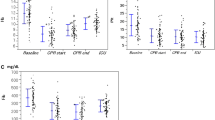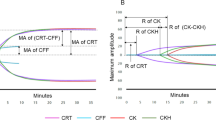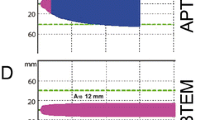Abstract
In a retrospective case-control review, we evaluated preoperative coagulation testing in patients undergoing major noncardiac operations to determine if routine testing benefits this group of patients. The platelet count (PC), prothrombin time (PT), and activated partial thromboplastin time (aPTT) in all patients undergoing major noncardiac surgery over a 22-month period were reviewed. The review was done both manually and by the computerized hospital information system. Major surgery was defined as procedures usually associated with significant bleeding. For each patient with abnormal results, another two control patients undergoing the same surgery and matched for age and gender were identified. Case and control patients were compared regarding a change in the management plan, use of blood products, blood loss, and bleeding complications by detailed chart review. A total of 828 patients undergoing nine different surgeries were reviewed. The incidence of abnormal PCs was 2.2% [95% confidence interval (CI) 1.2–3.2%] and that of abnormal PT/aPTTs was 2.1% (95% CI 1.1–3.1%). There were only two cases each of thrombocytopenia and prolonged PT/aPTT where the coagulation tests were not indicated clinically. Although (compared to controls) patients with abnormal tests had more changes in their anesthesia plan (36% vs. 2%, p<0.001) and platelet or fresh frozen plasma transfusions (50% vs. 9%, p<0.001), blood loss and the incidence of bleeding complications were not different. We conclude that the use of preoperative coagulation tests in patients undergoing major noncardiac surgery should still be guided by clinical assessment. The surgical procedure itself does not constitute an indication for testing.
Résumé
Dans une revue rétrospective de cas-témoin, nous avons cherché à savoir si un bilan de coagulation systématique pouvait être utile chez les patients opérés d’une intervention majeure non-cardiaque. On a analysé les résultats de la numération plaquettaire (NP), le taux de prothrombine (TP) et le temps de thromboplastine partielle activée (TTPA) chez tous les patients ayant eu une intervention chirurgicale majeure non cardiaque pendant une péroide de 22 mois. La revue a été effectuée manuellement et par un système informatique hospitalier. La chirurgie majeure a été définie comme un procédé où on pouvait observer une hémorragie importante. Pour chaque patient ayant un résultat anormal, on a identifié deux autres patients de contrôle ayant eu le même type de chirurgie, et apparié pour l’âge et sexe. Par une revue détaillée du dossier médical, on a pu comparer les modifications du traitement, l’utilisation de produits sanguins, les pertes sanguines, et les complications hémorrhagiques. On a revu les dossiers de 828 patients ayant eu neuf types différents de chirurgie. L’incidence de NP anormale était de 2.2% (IC 95%: 1.2–3.2%) et celle d’un TP/TTPA anormal de 2.1% (IC 95%: 1.1–3.1%). Il y avait seulement deux cas de thrombocytopenic ou d’allongement du TP/TTPÀ lorsque les tests de coagulation n’étaient pas indiqués initialement. Bien que, comparé aux contrôles, il y avait plus de patients avec des tests anormaux qui avaient un changement du type d’anesthésie (36% vs. 2%, p<0.001), nécessitant des transfusions de plaquettes ou de plasma frais (50% vs. 9%, p<0.001), les pertes sanguines et l’incidence de complications hémorragiques ne différaient pas. Nous avons conclu que la demande des tests de coagulation préopératoires chez les patients devant avoir une chirurgie majeure noncardiaque doit toujours être guidée par l’évaluation clinique. Le procédé chirurgical en lui-même ne constitue pas l’indication d’un bilan de coagulation.
Resumen
Mediante una revisión retrospectiva de casos-controles, se hizo la evaluación de las pruebas de coagulación preoperatorias en pacientes sometidos a operaciones no cardíacas con el objeto de determinar si la realización rutinaria de éstas es de beneficio. Se practicaron las siguientes pruebas en todos los pacientes sometidos a este tipo de cirugía en un periodo de 22 meses: recuento de plaquetas (RP), tiempo de protombina (PT) y tiempo parcial de tromboplastina activada (aPTT). La revisión fue hecha manualmente y mediante el sistema de información computadorizada del hospital. Se definió la cirugía mayor como la que involucra procedimientos que usualmente se acompañan de sangrado significativo. Por cada paciente con resultados anormales, se identificaron otros dos pacientes control sometidos al mismo tipo de cirugía y de edad y sexo similares. Los pacientes del estudio y los controles fueron comparados en relación a un cambio de manejo, al uso de sangre y sus productos, a la pérdida de sangre y a las complicaciones hemorrágicas mediante meticuloso análisis de las historias clínicas. En total se revisaron 828 pacientes sometidos a 9 tipos diferentes de cirugía. La incidencia de RP anormal fue 2.2% (95% IC: 1.2–3.2%), y la de PT/aPTT fue 2.1% (95% IC: 1.1–3.1%). Sólo se encontraron dos casos, cada uno de trombocitopenia y de PT/aPTT, en que Sas pruebas de coagulación no aparecían clínicamente indicadas. Aunque en comparación con los controles los pacientes con pruebas anormales exhibieron más cambios en el plan de anestesia (36% vs. 2%, p<0.001) y transfusión de plaquetas o de plasma fresco congelado (50% vs. 9%, p<0.001), la pérdida de sangre y la incidencia de complicaciones hemorrágicas no fueron diferentes. Nuestra conclusión es que la orden de pruebas de coagulación preoperatorias en pacientes que van a ser sometidos a cirugía mayor no cardíaca, debe ser guiada por la evaluación clínica. El procedimiento quirúrgico, de por sí, no constituye una indicación para ordenarlas.
Similar content being viewed by others
References
Adams JG Jr, Weigelt JA, Poulos E. Usefulness of preoperative laboratory assessment of patients undergoing elective herniorrhaphy. Arch. Surg. 1992;127:801–805
Kaplan EB, Sheiner LB, Boeckmann AJ, et al. The usefulness of preoperative laboratory screening. J.A.M.A. 1985;253:3576–3581
Narr BJ, Hansen TR, Warner MA. Preoperative laboratory screening in healthy Mayo patients: cost-effective elimination of tests and unchanged outcomes. Mayo Clin. Proc. 1991;66:155–159
Perez A, Planell J, Bacardaz C, et al. Value of routine preoperative tests: a multicentre study in four general hospitals. Br. J. Anaesth. 1995;74:250–256
Burns ER, Lawrence C. Bleeding time: a guide to its diagnostic and clinical utility. Arch. Pathol. Lab. Med. 1989;113:1219–1224
Houry S, Georgeac C, Hay JM, et al. A prospective multicenter evaluation of preoperative hemostatic screening tests: the French Association for Surgical Research. Am. J. Surg. 1995;170:19–23
Rohrer MJ, Michelotti MC, Nahrwold DL. A prospective evaluation of the efficacy of preoperative coagulation testing. Ann. Surg. 1988;208:554–557
Suchman AL, Griner PF. Diagnostic uses of the activated partial thromboplastin time and prothrombin time. Ann. Intern. Med. 1986;104:810–816
Suchman AL, Mushlin AI. How well does the activated partial thromboplastin time predict postoperative hemorrhage? J.A.M.A. 1986:256:750–753
Peterson P, Hayes TE, Arkin CF, et al. The preoperative bleeding time test lacks clinical benefit: College of American Pathologists’ and American Society of Clinical Pathologists’ position article. Arch. Surg. 1998;133:134–139
Velanovich V. Preoperative laboratory screening based on age, gender, and concomitant medical diseases. Surgery 1994;115:56–61
Faris PM, Spence RK, Larholt KM, et al. The predictive power of baseline hemoglobin for transfusion risk in surgery patients. Orthopedics 1999;22:s135-s140
Meneghini L, Zadra N, Zanette G, et al. The usefulness of routine preoperative laboratory tests for one-day surgery in healthy children. Paediatr. Anaesth. 1998;8:11–15
Schein OD, Katz J, Bass EB, et al. The value of routine preoperative medical testing before cataract surgery: study of medical testing for cataract surgery. N. Engl. J. Med. 2000;342:168–175
Zwack GC Derkay CS. The utility of preoperative hemostatic assessment in adenotonsillectomy. Int. J. Pediatr. Otorhinolarvngol. 1997;39:67–76
Kang J, Brodsky L. Danziger I, et al. Coagulation profile as a predictor for post-tonsillectomy and adenoidectomy (T + A) hemorrhage. Int. J. Pediatr. Otorhinolarvngol. 1994;28:157–165
Dorman BH, Spinale FG, Bailey MK, et al. Identification of patients at risk for excessive blood loss during coronary artery bypass surgery: thromboelastography versus coagulation screen. Anesth. Analg. 1993;76:694–700
American Society of Anesthesiologists Committee on Transfusion Medicine. Questions and Answers about Transfusion Practices. 2nd edition. edition. Park Ridge, ILL, American Society of Anesthesiologists, 1993:3–6
Schoen I, Brooks SH. Judgement based on 95% confidence limits: a statistical dilemma involving multitest screening and proficiency testing of multiple specimens. Am. J. Clin. Pathol. 1970;53:190–193
Tape TG, Mushlin AI. The utility of routine chest radiographs. Ann. Intern. Med. 1986;104:663–670
Goldberger AL, O’Konski M. Utility of the routine electrocardiogram before surgery and on general hospital admission: critical review and new guidelines. Ann. Intern. Med. 1986:105:552–557
Lawrence VA, Gafni A, Gross M. The unproven utility of the preoperative urinalysis: economic evaluation. J. Clin. Epidemiol. 1989;42:1185–1192
Ramsey G, Arvan DA, Stewart S, et al. Do preoperative laboratory tests predict blood transfusion needs in cardiac operations? J. Thorac. Cardiovasc. Surg. 1983;85:564–569
Muskett AD, McGreevy JM. Rational preoperative evaluation. Postgrad. Med. J. 1986;62:925–928
Robbins JA, Rose SD. Partial thromboplastin time as a screening test. Ann. Intern. Med. 1979;90:796–797
Zilla P, von Oppell U, Deutsch M. The endothelium: a key to the future. J. Card. Surg. 1993;8:32–60
Nabel EG. Biology of the impaired endothelium. Am. J. Cardiol. 1991;68:6C-8C
Sessler DI. Mild perioperative hypothermia. N. Engl. J. Med. 1997;336:1730–1737
Schmied H, Kurz A, Sessler DI, et al. Mild hypothermia increases blood loss and transfusion requirements during total hip arthroplasty. Lancet 1996;347:289–292
Turitto VT, Hall CL. Mechanical factors affecting hemostasis and thrombosis. Thromb. Res. 1998;92:S25-S31
Author information
Authors and Affiliations
Corresponding author
Additional information
Published Online: February 6, 2002
Rights and permissions
About this article
Cite this article
Ng, K.F.J., Lai, K.W. & Tsang, S.F. Value of preoperative coagulation tests: Reappraisal of major noncardiac surgery. World J. Surg. 26, 515–520 (2002). https://doi.org/10.1007/s00268-001-0260-8
Issue Date:
DOI: https://doi.org/10.1007/s00268-001-0260-8




